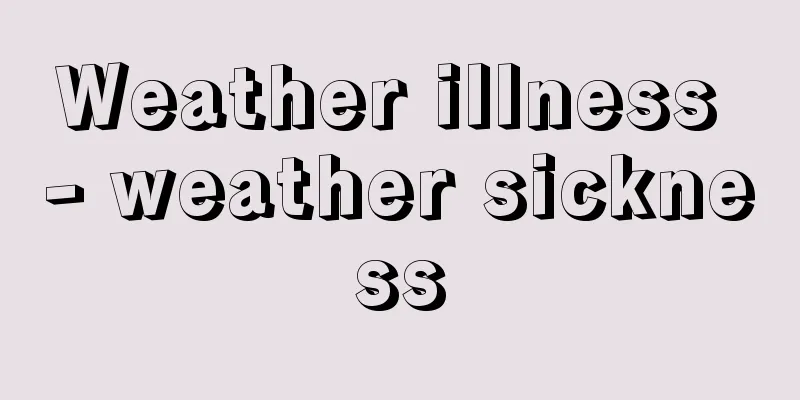Weather illness - weather sickness

|
This refers to a series of diseases whose symptoms worsen or attacks are induced by weather changes or certain weather conditions. The first to come to mind are rheumatoid arthritis and neuralgia. It is well known from experience that the pain of these diseases is more likely to appear or worsen under certain weather conditions, and the fact that this is often called weather pain speaks volumes about the situation in recent times. Other diseases that are affected by weather include bronchial asthma, myocardial infarction, cerebral hemorrhage, cholelithiasis, and Behcet's disease. In particular, the passage of a front (a discontinuous boundary created by the contact of air masses with different properties), which is prone to sudden changes in weather conditions, seems to have a major impact, and it has been proven that attacks of these diseases are more likely to occur during the passage of a front than before or after. To clarify the relationship between weather and disease, the occurrence and progression of a target disease in a certain area are observed in detail over a certain period of time, and a correlation is examined between this and changes in meteorological conditions observed at the same time. Regarding the mechanism of meteorological illness, there are the following theories on how weather changes affect the living body: (1) The theory that reduced pressure caused by the approach of a front (approaching low pressure) mobilizes histamine or histamine-like substances in the body, causing fluid retention in the body and increasing smooth muscle contraction, vascular permeability, and inflammatory responses, inducing meteorological illness; (2) The theory that weather changes affect the autonomic nervous system, first increasing the sensitivity of the parasympathetic nervous system, and then the sympathetic nervous system; (3) The theory that weather changes are perceived as stress, activating the anterior pituitary gland and adrenal cortex system. The mechanism of such meteorological illness remains to be determined through further research. On the other hand, in cases where there is a clear relationship between certain weather conditions and a disease, attempts have already been made to use an artificial climate chamber to artificially create weather conditions (temperature, humidity, air pressure, etc.) that are favorable to the progression of the disease, and to apply this to the treatment of diseases such as rheumatoid arthritis and bronchial asthma. [Masao Kaji] "Humans, Weather, and Diseases" edited by Masao Kaji (NHK Books)" ▽ "Pediatrics MOOK 14 Meteorological Medicine" edited by Kazuo Kasai (1980, Kanehara Publishing) Source: Shogakukan Encyclopedia Nipponica About Encyclopedia Nipponica Information | Legend |
|
気象の変化や一定の気象条件下で症状が悪化したり、発作が誘発されたりする一連の病気をいう。まずあげられるのは関節リウマチと神経痛である。これらの病気の痛みの出現や悪化が、ある気象条件下でおこりやすいことは経験的によく知られており、しばしばそれを天気痛とよぶことからも、この間の事情をよく物語っている。そのほか、気管支喘息(ぜんそく)、心筋梗塞(こうそく)、脳出血、胆石症、ベーチェット病などが気象の影響を受ける。ことに気象条件に急激な変化をおこしやすい前線(性質の違う気団の接触によって生ずる不連続な境界)の通過という条件が大きな影響を及ぼすようであり、これらの病気の発作は、いずれも前線通過の前後に比べて通過時におこりやすいことが証明されている。 気象と病気の関係を明らかにするには、一定の地域において、対象とする病気の発生状況や経過をある期間にわたって詳細に観察し、それと並行して観測した気象条件の変動との間に関連性があるか否かを検討する。 気象病のメカニズムに関連して、気象変化が生体にどのような影響を与えるかという問題に対して次のような説がある。(1)前線の接近(低気圧の接近)による減圧では、体内にヒスタミンまたはヒスタミン様物質が動員され、体内の水分が貯留し、平滑筋の収縮、血管の透過性、炎症反応が増強するため、気象病が誘発されるとする説、(2)気象変化が自律神経に影響を与えるため、最初は副交感神経の感受性が亢進(こうしん)、ついで交感神経の感受性が亢進するとする説、(3)気象の変化をストレスとして考え、下垂体前葉、副腎(ふくじん)皮質系が作動するためとの説がある。このような気象病のメカニズムについては今後の研究にまつところが大きい。 一方、一定の気象条件と病気との関係が明らかな場合には、人工気象室によって逆に病気の経過に有利な気象条件(温度、湿度、気圧など)を人工的につくりだして病気の治療に応用しようという試みが、すでに関節リウマチや気管支喘息などで行われている。 [加地正郎] 『加地正郎編『人間・気象・病気』(NHKブックス)』▽『笠井和編『小児科MOOK14 気象医学』(1980・金原出版)』 出典 小学館 日本大百科全書(ニッポニカ)日本大百科全書(ニッポニカ)について 情報 | 凡例 |
Recommend
Receptum
...It can be said that this is the origin of the ...
Kannosha
...This farming method aimed to increase yields b...
Pierre Abélard
A medieval French philosopher and theologian. His...
Paul Berg
American molecular biologist. Born in New York. H...
Atsugi Air Base
...The plateau is carved by the Tade River and it...
Midpoint Link Theorem
A theorem that states that a line segment connect...
"Awashima wedding ceremony model"
...In Joruri, the most famous is "Futaba Rei...
Ryuta Iida
1920-2007 A haiku poet from the late Showa to Hei...
Seven kinds of daughters
Kabuki dance. Nagauta. Original title: Seven Types...
King Souben - King Souben
…He was of low social standing, and when he was p...
Cupreous Polished Chafer
…The body is copper or copper-green in color and ...
Agataiha - Prefecture
A school of Japanese classics and waka poetry. &q...
Light difference
The difference between the actual time when a phen...
Dingyue Mountains - Hinoto Dakesanchi
A mountain range that stretches along the border ...
Mediastinal emphysema
...Treatment involves addressing the underlying d...









